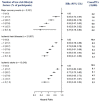Adherence to Healthy Lifestyle and Cardiovascular Diseases in the Chinese Population
- PMID: 28254173
- PMCID: PMC6675601
- DOI: 10.1016/j.jacc.2016.11.076
Adherence to Healthy Lifestyle and Cardiovascular Diseases in the Chinese Population
Abstract
Background: Adherence to a combination of healthy lifestyle factors has been related to a considerable reduction of cardiovascular risk in white populations; however, little is known whether such associations persist in nonwhite populations like the Asian population.
Objectives: This study aimed to examine the associations of a combination of modifiable, healthy lifestyle factors with the risks of ischemic cardiovascular diseases and estimate the proportion of diseases that could potentially be prevented by adherence to these healthy lifestyle patterns.
Methods: This study examined the associations of 6 lifestyle factors with ischemic heart disease and ischemic stroke (IS) in the China Kadoorie Biobank of 461,211 participants 30 to 79 years of age who did not have cardiovascular diseases, cancer, or diabetes at baseline. Low-risk lifestyle factors were defined as nonsmoking status or having stopped smoking for reasons other than illness, alcohol consumption of <30 g/day, a median or higher level of physical activity, a diet rich in vegetables and fruits and limited in red meat, a body mass index of 18.5 to 23.9 kg/m2, and a waist-to-hip ratio <0.90 for men and <0.85 for women.
Results: During a median of 7.2 years (3.3 million person-years) of follow-up, this study documented 3,331 incident major coronary events (MCE) and 19,348 incident ISs. In multivariable-adjusted analyses, current nonsmoking status, light to moderate alcohol consumption, high physical activity, a diet rich in vegetables and fruits and limited in red meat, and low adiposity were independently associated with reduced risks of MCE and IS. Compared with participants without any low-risk factors, the hazard ratio for participants with ≥4 low-risk factors was 0.42 (95% confidence interval: 0.34 to 0.52) for MCE and 0.61 (95% confidence interval: 0.56 to 0.66) for IS. Approximately 67.9% (95% confidence interval: 46.5% to 81.9%) of the MCE and 39.1% (95% confidence interval: 26.4% to 50.4%) of the IS cases were attributable to poor adherence to healthy lifestyle.
Conclusions: Adherence to healthy lifestyle may substantially lower the burden of cardiovascular diseases in Chinese.
Keywords: cardiovascular diseases; cohort studies; health behavior; lifestyle.
Copyright © 2017 The Authors. Published by Elsevier Inc. All rights reserved.
Figures


Comment in
-
Lifestyle and Cardiovascular Disease: More Work to Do.J Am Coll Cardiol. 2017 Mar 7;69(9):1126-1128. doi: 10.1016/j.jacc.2016.12.019. J Am Coll Cardiol. 2017. PMID: 28254174 No abstract available.
-
Low-Risk Lifestyle Is a Strong Predictor of Outcomes Across Populations With Different Cardiovascular Health Manifestations.J Am Coll Cardiol. 2017 Aug 15;70(7):910. doi: 10.1016/j.jacc.2017.04.071. J Am Coll Cardiol. 2017. PMID: 28797364 No abstract available.
-
Reply: Low-Risk Lifestyle Is a Strong Predictor of Outcomes Across Populations With Different Cardiovascular Health Manifestations.J Am Coll Cardiol. 2017 Aug 15;70(7):910-911. doi: 10.1016/j.jacc.2017.05.069. J Am Coll Cardiol. 2017. PMID: 28797365 No abstract available.
References
-
- Weintraub WS, Daniels SR, Burke LE, et al. Value of primordial and primary prevention for cardiovascular disease: a policy statement from the American Heart Association. Circulation. 2011;124:967–90. - PubMed
-
- United States. Public Health Service. Office of the Surgeon General. The health consequences of smoking--50 years of progress: a report of the Surgeon General: executive summary. Rockville, MD: U.S. Dept. of Health and Human Services, Public Health Service, Office of the Surgeon General; 2014.
MeSH terms
Grants and funding
- R01 DK091718/DK/NIDDK NIH HHS/United States
- P30 DK046200/DK/NIDDK NIH HHS/United States
- R01 HL034594/HL/NHLBI NIH HHS/United States
- R01 DK078616/DK/NIDDK NIH HHS/United States
- MC_U137686851/MRC_/Medical Research Council/United Kingdom
- MC_UU_12026/2/MRC_/Medical Research Council/United Kingdom
- 202922/WT_/Wellcome Trust/United Kingdom
- R21 HL126024/HL/NHLBI NIH HHS/United States
- MC_PC_14135/MRC_/Medical Research Council/United Kingdom
- U01 DK078616/DK/NIDDK NIH HHS/United States
- R01 DK100383/DK/NIDDK NIH HHS/United States
- R01 HL071981/HL/NHLBI NIH HHS/United States
- A8760/CRUK_/Cancer Research UK/United Kingdom
- R01 HL132254/HL/NHLBI NIH HHS/United States
- UM1 DK078616/DK/NIDDK NIH HHS/United States
- 088158/WT_/Wellcome Trust/United Kingdom
- 104085/WT_/Wellcome Trust/United Kingdom
LinkOut - more resources
Full Text Sources
Other Literature Sources
Medical

